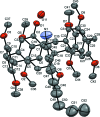Single-crystal X-ray diffraction study of a host-guest system comprising monofunctionalized-hydroxy pillar[5]arene and 1-octa-namine
- PMID: 30116574
- PMCID: PMC6072997
- DOI: 10.1107/S2056989018010034
Single-crystal X-ray diffraction study of a host-guest system comprising monofunctionalized-hydroxy pillar[5]arene and 1-octa-namine
Abstract
Co-crystallization of a monofunctionalized hy-droxy pillar[5]arene with 1-octa-namine resulted in the formation of an inclusion complex where the alkyl chain is threaded in the macrocycle cavity, namely 1,2,3,4-(1,4-dimeth-oxy)-5-(1-hy-droxy-4-meth-oxy)-pillar[5]arene-1-octa-namine-water (1/1/1), C44H48O10·C8H19N·H2O. The guest compound is stabilized inside the cavity by hydrogen-bonding and C-H⋯π inter-actions. The water mol-ecule in the asymmetric unit mediates the formation of a supra-molecular dimer by hydrogen-bonding inter-actions. These functionalized-pillararene hosts expand the possibility of exploring more supra-molecular inter-actions with various guest species.
Keywords: Functionalized pillararene; crystal structure; encapsulation; host–guest interaction.
Figures



Similar articles
-
Crystal structure and supra-molecular features of a host-guest inclusion complex based on A1/A2-hetero-difunctionalized pillar[5]arene.Acta Crystallogr E Crystallogr Commun. 2024 Sep 24;80(Pt 10):1069-1074. doi: 10.1107/S2056989024009216. eCollection 2024 Sep 1. Acta Crystallogr E Crystallogr Commun. 2024. PMID: 39372180 Free PMC article.
-
1-[1,4-Bis(but-3-en-1-yl-oxy)]-2,3,4,5-(1,4-dimeth-oxy)pillar[5]arene-1,4-di-bromo-butane 1:1 inclusion complex.IUCrdata. 2023 Jul 14;8(Pt 7):x230588. doi: 10.1107/S2414314623005886. eCollection 2023 Jul. IUCrdata. 2023. PMID: 37937131 Free PMC article.
-
Crystal structure of a supra-molecular lithium complex of p-tert-butyl-calix[4]arene.Acta Crystallogr E Crystallogr Commun. 2018 Apr 17;74(Pt 5):575-579. doi: 10.1107/S2056989018001834. eCollection 2018 May 1. Acta Crystallogr E Crystallogr Commun. 2018. PMID: 29850071 Free PMC article.
-
Crystal structure and supra-molecular features of a bis-urea-functionalized pillar[5]arene.Acta Crystallogr E Crystallogr Commun. 2023 Oct 19;79(Pt 11):1044-1048. doi: 10.1107/S2056989023009003. eCollection 2023 Nov 1. Acta Crystallogr E Crystallogr Commun. 2023. PMID: 37936859 Free PMC article.
-
Host-guest supra-molecular inter-actions between a resorcinarene-based cavitand bearing a -COOH moiety and acetic acid.Acta Crystallogr E Crystallogr Commun. 2019 Feb 22;75(Pt 3):397-401. doi: 10.1107/S2056989019002512. eCollection 2019 Mar 1. Acta Crystallogr E Crystallogr Commun. 2019. PMID: 30867957 Free PMC article.
References
-
- Al-Azemi, T. F., Mohamod, A. A., Vinodh, M. & Alipour, F. H. (2018). Org. Chem. Front. 5, 10–18.
-
- Al-Azemi, T. F., Vinodh, M., Alipour, F. H. & Mohamod, A. A. (2017). J. Org. Chem. 82, 10945–10952. - PubMed
-
- Burla, M. C., Caliandro, R., Camalli, M., Carrozzini, B., Cascarano, G. L., De Caro, L., Giacovazzo, C., Polidori, G., Siliqi, D. & Spagna, R. (2007). J. Appl. Cryst. 40, 609–613.
-
- Han, J., Hou, X., Ke, C., Zhang, H., Strutt, N. L., Stern, C. L. & Stoddart, J. F. (2015). Org. Lett. 17, 3260–3263. - PubMed
-
- Han, C., Ma, F., Zhang, Z., Xia, B., Yu, Y. & Huang, F. (2010). Org. Lett. 12, 4360–4363. - PubMed
LinkOut - more resources
Full Text Sources
Other Literature Sources
